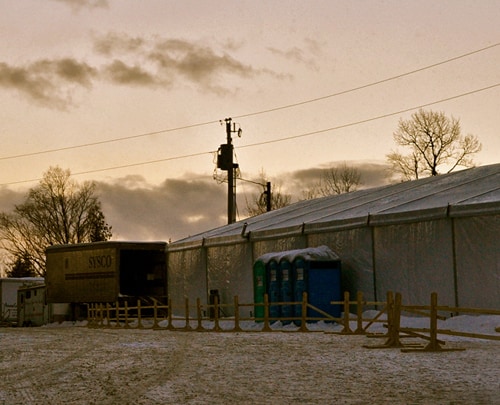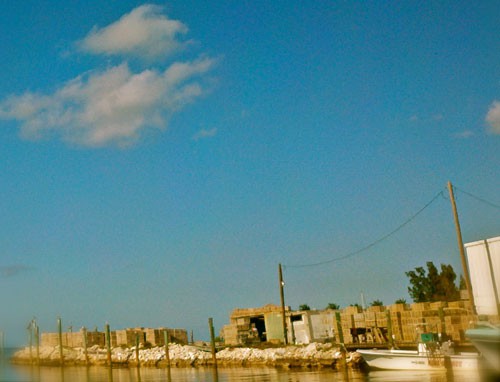Like any well-meaning but clueless tourist schmuck, I found myself tempted to Google “Florida Keys food” before my trip there last week. My trip was intended to be the perfect foil to my 18-day winter catering gig at the very top of Maine last month. Sun-drenched and breezy, the Keys were everything I imagined. I felt like an extra in a Jimmy Buffet video while hanging out on the lanai in a sarong, and constantly checking tiki bar clock—the clock with nothing but the number five. That part of the trip was blissfully—and fortunately–predictable. The dining plans? Not so much. Though I had some great recommendations from friends and blogs, I was a little mystified by the Keys. I knew good things awaited me, but I had a mental block about how to best avail myself of the possibilities.

Even before I was a chef in the formal sense, my travel itineraries were always based on which of my bucket list eateries were open and taking reservations. I would starve all day so I could experience everything all at once and in large, rich, and expensive quantities—or minuscule, rich, and expensive quantities, depending on the restaurant. Bonus points were given to places that featured local products and regional specialties and no penalties were given to any chef whose menu induced bloating, headaches, vomiting, dehydration, or any other unintended consequence of their important work.

Frankly, I wanted to do the same in Florida. But what with kids and everything, it just wasn’t practical to operate the same way; grade-schoolers going more than three hours without food does not a lovely family vacation make. Plus, my own parental units are second only to those grade-schoolers in terms of food intake frequency and timid palates. My mother’s dining out mantras, the “No added *insert sodium permutation here*, and ” “No added *insert flavor-enhancing and often beneficial oil or fat here*” demonstrate her preference for healthful foods, regardless of the occasion or mood. I often give her grief about it, but she’s right about one thing: it’s good to keep an eye out on the salt and fat, especially when there are bikinis involved. So that settled that: no four-hour glutton fests for me.
You can Google “Florida Keys food” right now, but I would take heed if you actually decide to try: the first result is a twitchy mid-90s Angelfire-style throwback so awesomely bad that you just may go blind. As my friend Jane often quips, “It’s so unfortunate-looking” yet just under a gaudy animated dancing fork and spoon lies The List: Key West Pink shrimp, stone crab claws, Florida lobster, and whatever’s coming up in the net at any given time, from Yellowfin Tuna to Yellowtail fish.
These, my friends, are the pearls of the Keys, and unlike other locales where the local specialty is the thing the tourists eat and the locals can’t afford, in the Keys, everyone’s eating from the list. The list IS the Keys.
What’s the theme? The ocean is the theme. I seriously had a hard time finding meat on menus, and if it was there, it was concessionary only, much like Fettuccine Alfredo chefs begrudgingly offer solely to appease picky patrons. My 10 year-old has ordered an, and I quote, “adult-size-cheeseburger-just-meat-and-cheese” for almost every restaurant meal he’s ever had, and he’s had a lot of them. He just likes them but with little meat to be had, the Keys offered a gentle nudge toward eating like the locals do because, well, there wasn’t any choice. So he tried some new things: he amazed himself when he ate some croutons and he licked a piece of fried conch on a dare. He just about blew his own mind over his enthusiasm for dipping bread in the herbed olive oil. But you know what? He was in the mood to experiment with new things— albeit new tan or brown things—and that was a great experience to witness.
I came to realize a few things about diet, activity, and health while I was on vacation, and believe me when I say I never intended to contemplate anything but the bottom of my Margarita glass while there. It just happened.
Supper was conch fritters, grilled calamari, and rare local tuna on greens with key limes and ginger sauce. Cocktails at the wharf were a couple of Mojitos packed with fresh local spearmint and limes with a dozen Gulf oysters on the half shell. Snack was a pound of Key West Pinks grilled for two or three minutes and eaten hot with lemon and orange wedges. There were no fries, no blue cheese dressing, no garlic bread sticks and, as the dockside bar sign said, “No melted butter. No exceptions.” So one of the best parts about eating like these particular locals is that we came home from vacation leaner than when we left.
In the Keys, the sun sets later, the climate is all but perfect, and the air is clean. There’s a lot of biking and walking going on and some people jog at night while others dabble in snorkeling or short walks on the beach. Meals are leisurely and they start surprisingly early: most restaurants and stores are closed by 9, so people aren’t hoovering the food in an hour before the bed calls and the reality show begins. The general tone in the Keys seems conducive to good health, both physically and mentally: “A steady pace wins the race.” Even the kids seemed to get it, rising a little later, hitting the pool for an hour, eating, lounging, and doing it all over again. We all resolved our various colds, tummy troubles, chapped lips and dry skin that we brought with us on vacation. Did the ailments just run their course? It’s possible, however it may be that the essential fatty acids, the lean proteins, and the fresh citrus we ate sped the recovery along. The relaxing atmosphere blocked emotional eating and its associated stress-induced weight gain. Best of all, the bikini-induced stress abated as well.
That’s what food in the Keys is all about: unencumbered and unmolested local seafood, served straight- up, screaming fresh, and authentically. Frankly, the food we eat as tourists reflects all of the aspects of our journey from the people we meet to the industries that supply their jobs. The bartender’s sucking back the same oysters you are when her shift is done because she’s worked hard and she’s treating herself. The dishwasher is eating his supper out of his employer’s kitchen because the food is good and the price is right. The liquor store cashier figures she’ll bring the rest of her key limes into the shop to give away with the tequila since her kids are sick of limeade. And at the Cuban juice bar in Key Largo, the arriving tourist rubs shoulders with the electrician returning home from work in Miami: they’re both heading into the Keys to relax, to re-energize, and to enjoy a meal—perhaps the same meal (or at the very least, the croutons)—with family.
About the Expert Chef
Erin Dow balances three food worlds. As a mother of three young children, she’s fighting the battle every parent faces: how to keep her kids interested in the foods that keep them healthy.
As the chef and owner of her catering company Eatswell Farm, she utilizes original recipes and techniques–focused on enhancing the enjoyment of locally-sourced ingredients–to best interpret the client’s vision. And as Consulting Executive Chef for Falmouth-based Professional Catering Services, a business specializing in production and backstage catering for concerts, she develops and executes menus that accommodate the strict nutritional requirements of the music industry elite.
Erin and her family raise their own chicken for meat and eggs, have dabbled in pastured Narragansett turkeys, and have a very weedy but very large and productive garden.